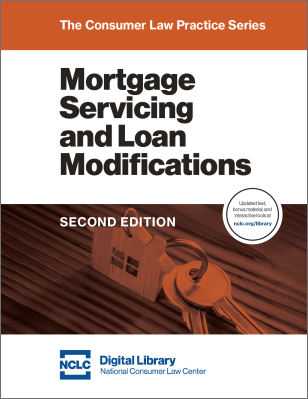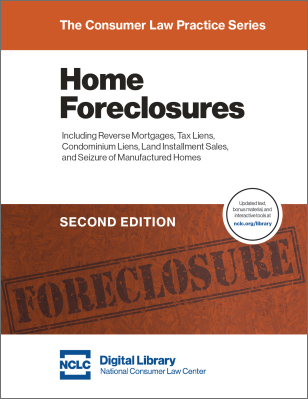Many homeowners have received a forbearance on their VA mortgage payments during the COVID-19 pandemic, but the mortgage payments were deferred and not forgiven. See NCLC’s Mortgage Servicing and Loan Modifications § 12.3.7.3. Homeowners who have recovered from COVID-19 hardships will soon be exiting the forbearance program, and then these homeowners must address both the past deferred payments and the new monthly mortgage payments. This takes on added significance since the moratorium on foreclosure of VA mortgages is scheduled to expire on June 30, 2021, if the expiration date is not extended again.
The VA has just issued a final rule setting out a “partial claim” program that, effective July 27, 2021, allows homeowners to resume their new regular monthly mortgage payments without first having to pay the past mortgage payments that were forborne under the COVID-19 program. See 86 Fed. Reg. 28,692 (May 28, 2021). This final rule will provide homeowners significantly better protection than the VA had initially set out last December in its first proposal for a final rule. See 85 Fed. Reg. 79,142 (Dec. 9, 2020).
The final rule brings the VA’s partial claim program into alignment with other federally related programs dealing with those exiting COVID-19 related mortgage forbearances. For a description of these other forbearance exit programs see NCLC’s Mortgage Servicing and Loan Modifications §§ 12.3.4.3.2 (Fannie Mae), 12.3.5.2.2 (Freddie Mac), 12.3.6.4 (FHA), 12.3.8.4 (USDA).
Of special note, links to NCLC’s Mortgage Servicing and Loan Modifications § 12.3 for a limited time are all open to the public.
This article also lists homeowner options when a homeowner with a VA mortgage coming out of forbearance cannot afford the new, regular monthly charges. These VA options are examined in more detail at NCLC’s Mortgage Servicing and Loan Modifications § 9.2.2.
VA Allows Further Deferral of Forborne Payments, Allowing Borrowers to Resume Their Regular Monthly Payments
The VA’s new program allows servicers to offer a “partial claim” option to VA-guaranteed borrowers to bring their loans current. The partial claim option is modeled after a long-standing FHA program. See NCLC’s Mortgage Servicing and Loan Modifications Chapter 8. The partial claim involves the mortgage servicer making a claim on the VA for a portion of the outstanding mortgage balance—in this case the portion equal to the forborne payments.
The borrower then owes the partial claim amount to the VA at 0% interest and only due at the end of the mortgage loan. There are no monthly payments required from the borrower to the VA for repayment of the partial claim. After the VA pays the partial claim, borrowers restart their pre-hardship mortgage payments to the mortgage servicer with the same monthly payment as before the forbearance.
The partial claim program is available for VA-guaranteed borrowers who are exiting COVID-19 forbearance plans and who were current or less than thirty days past due as of March 1, 2020. Borrowers must indicate to the mortgage servicer that they can resume their former monthly payment. The partial claim loan cannot exceed 30% of the loan’s unpaid principal balance.
The VA’s Final Rule Is Significantly More Protective Than Their Original Proposal
The new VA rule going into effect July 27 is a distinct improvement over the VA’s original December 9, 2020, proposal. In response to comments from a coalition of consumer advocates led by the National Consumer Law Center (NCLC) and also from the mortgage industry, the VA eliminated several problematic features from their original proposal.
The VA’s original proposal required borrowers to repay the partial claim within 10 years but did not require any payments during the first five years of the term. As a result, borrowers still living in their homes would have faced a significant payment shock after the first five years of the partial claim loan. In addition, the VA proposed charging borrowers 1% interest and limiting the size of the partial claim to 15% of the borrower’s unpaid balance. It also required a full financial documentation for borrowers wanting to access the partial claim, which would impose a significant barrier to borrowers actually accessing the program.
The VA eliminated all of these problematic loan features and instead provided a program in line with the FHA’s partial claim program. See NCLC’s Mortgage Servicing and Loan Modifications § 12.3.6.4. By making these changes, the VA increased the amount of assistance borrowers can receive and eliminated unnecessary barriers to accessing the programs. VA-guaranteed borrowers no longer face payment shock and additional interest payments.
New Options for VA Borrowers Unable to Afford Their Pre-Hardship Mortgage Payments
The new final rule delays any obligation to repay the past forborne mortgage payments, allowing homeowners to resume their normal monthly mortgage payment. The VA’s new partial claim program does not help borrowers who now cannot afford to pay their new regular mortgage payments. These borrowers should consider the VA’s pre-existing loan modification programs including:
- Modification, where a lender may modify the mortgage loan by changing one or more of the terms of the loan, including the interest rate or term, and then re-amortizing the balance due. See NCLC’s Mortgage Servicing and Loan Modifications §§ 9.2.2.4, 12.3.7.4.
- Refinancing, where a borrower refinances a high-interest loan at a current, lower rate with the VA’s interest rate reduction refinancing loan. The new loan could also be used to obtain a shorter term or a fixed interest rate or to fund energy efficiency improvements. See NCLC’s Mortgage Servicing and Loan Modifications § 9.2.2.9.
- Refunding, where the VA buys the loan when it believes that the default can be cured through various relief measures and the lender is unable or unwilling to grant further relief. Other loss mitigation options may then be available to the homeowner. The VA, for example, may agree to reduce the interest rate well below the market rate. The VA infrequently offers this option. See NCLC’s Mortgage Servicing and Loan Modifications § 9.2.2.8.
- Compromise sale, where the property is sold to a third party for an amount insufficient to pay off the loan and the servicer releases the lien and waives the deficiency in exchange for the sale proceeds. Relocation assistance of up to $1500 is available to borrowers who complete a compromise sale. SeeNCLC’s Mortgage Servicing and Loan Modifications § 9.2.2.5.
- Deed in lieu of foreclosure is a voluntary transfer of the property to the holder of the VA-guaranteed loan. Relocation assistance, also known as “cash for keys,” of up to $1500 is available to borrowers who successfully complete a deed in lieu of foreclosure. See NCLC’s Mortgage Servicing and Loan Modifications § 9.2.2.6.
- Assumption, where the lender grants forbearance for a reasonable period of time to permit the sale or transfer of the property. If approved, this releases the borrower from any future liability to the VA, including liability for any loss resulting from the default of the purchaser or subsequent owner of the home. See NCLC’s Mortgage Servicing and Loan Modifications § 9.2.2.7.S



